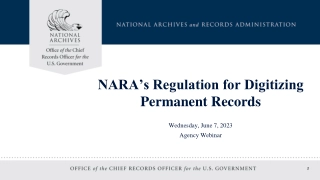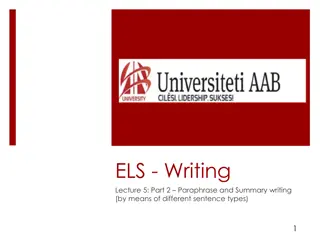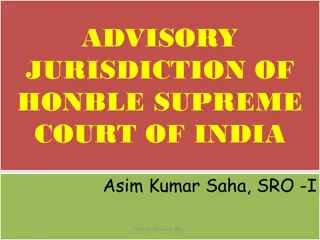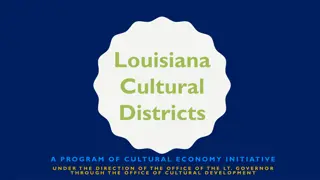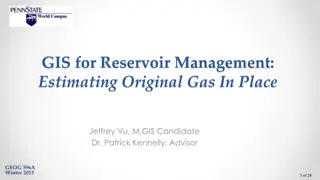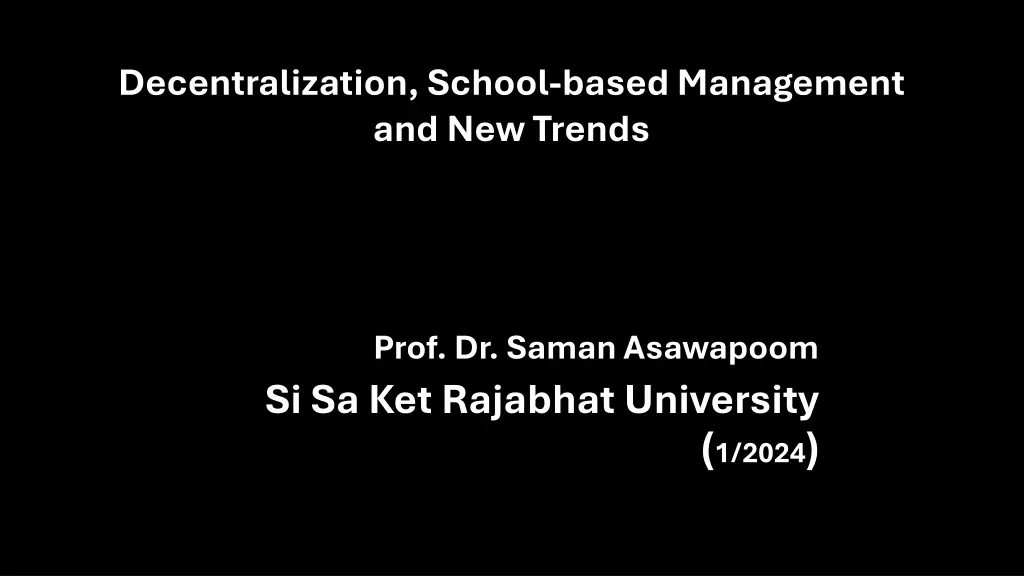
Understanding Decentralization in Organizational Management
Explore the concept of decentralization, its role in organizational management, various models such as Delegating Authority Decentralization and Transferring Authority Decentralization, and the importance of choosing the right approach for successful implementation. Discover why decentralization is crucial for large organizations, both public and private, and how it can lead to effective decision-making and accountability.
Download Presentation

Please find below an Image/Link to download the presentation.
The content on the website is provided AS IS for your information and personal use only. It may not be sold, licensed, or shared on other websites without obtaining consent from the author. If you encounter any issues during the download, it is possible that the publisher has removed the file from their server.
You are allowed to download the files provided on this website for personal or commercial use, subject to the condition that they are used lawfully. All files are the property of their respective owners.
The content on the website is provided AS IS for your information and personal use only. It may not be sold, licensed, or shared on other websites without obtaining consent from the author.
E N D
Presentation Transcript
Decentralization, School-based Management and New Trends Prof. Dr. Saman Asawapoom Si Sa Ket Rajabhat University (1/2024)
Decentralization is a management trend and necessary approach for large organizations, either private or public ones. Most countries adopt decentralization policy and try hard to implement the system, but unlikely succeed. Why, you shall see soon. Decentralization is a sky-pointed concept (wherever you point is a sky) and a sky-aim practice (Saman Asawapoom, 2000) because any degree of authority that is not totally kept at the central or headquarter, it is said to be decentralized. So, decentralization itself is not the matter , but the right decentralization model is. Let s not focus on decentralization or not decentralization , but choose and implement the right one.
Decentralization is a transitional degree of authority between Central and Not Central Authorities: Any point away from the center is decentralization Center Not Center than decentralization or not decentralization. So, the crucial implication is the right approach rather
Decentralization is proposed and practiced in many forms, but I conclude in two forms: Delegating Authority Decentralization and Transferring Authority Decentralization (Saman Asawapoom, 2000) Delegating Authority Decentralization refers to a decentralization model that some authorities are delegated to subordinates to make decision and manage the organization under his or her responsibility, but the central authority still holds the authority and has the right to draw back any time. Private sectors use this model because they have the true authority (power), while public organizations have representation authority , authorized by the citizens (with free will or being forced to grant authority).
Transferring Authority Decentralization (Originally, I used the term Autonomy Decentralization ) refers to a decentralization model,that function and authority are divided between the central authority unit and subordinate unit, and the function and authority divided are fully transferred to the head of the sub-unit who is responsible to make all decisions to run the unit, administrate, evaluate, and being accountable for the results. I, believe this model is appropriate for public administration if decentralization is THE choice.
I believe that Transferring Decentralization is the most suitable for public organization because the citizens are the true owners of public sectors, including the government . The cabinet and all heads of public organizations are not the owner or the public organizations. The cabinet, and public organizations are given right and authority by the citizens through representatives or by means of dictatorship to run the government, and public organizations, respectively. Success or fail to do the job, it affects all citizens in the country. Unlike the private enterprise, there is an owner or a group of owners. So, they have authority to delegate so someone they trust, and take the authority back if they detect something goes wrong. Running the public sector, shared responsibility with full accountability is more appropriate.
But why many governments, if not most, still implement delegating decentralization ? Based on my research, here might be the reasons: 1. Technocrats who design public governing system do not know or not understand the concept I mentioned above. 2. Elites, or public power figures or partisans do not want to lose power, prerogative, or even benefit of holding power. 3. Misunderstanding between separating territory and work-and-authority divided , and not divided and ruled either. 4. Everything is clearly known, but they scare of changes! This is just about all I would like to share about Decentralization
Now, the next concept is School-based Management which is closely related to decentralization . The concept has been originated in the context of American schools, where education is operated in Transferring Authority Decentralization . So, if it is to be used in different context, it is likely unsuccessful like in Thai situation. However, it is worthwhile to share and discuss. School-based Management comes under different names besides School-based Management , such as Site-based Management, Site-based Decision, Shared Decision Management, or Local Management of Schools. All refers to the same form of management: Decision and Management are made at school site according to school context, problems and needs.
Assumptions of External control (traditional approach) are: -Unification of educational goals -Simple and nearly statistic educational environment -No need for educational reform -Standardization and stability oriented -Pusuit of quntity (I do not quite agree) Assumptions of Internatl control (reformed appraoch) are: -Multiplicity of educational goals -Complex and changing educational environment -Need for educational reform -Effectiveness and adaptation oriented -Pursuit of quality (I do not quite agree) (Cheng, 1996)
Princitple of standard structure -Standard methods and procedures to achieve goals -Emphasizes generalization Principle of centralization -Things, big or small, are carefully controlled to aviod problems -Pursues prodedural control Principle of implementinbg system -Externally controlled -Passively receptive -Not accountable Principle of structural control -Enforcers external supervision -Expansion of bureaucratic system Theories used to manage school according to External control: (Cheng, 1996)
Princitple of equifinality -Many different ways to achieve goals -Emphasizes flexibility Principle of decentralization -Problems are inevitable, should be solved at where they happen in time -Looks for efficiency and proplem solving Principle of self-management system -Self-management -Actively explotative -Responsible (I prefer Accountable over Responsible) Principle of human initiative -Develop intenal human resources -Wide participation of school member (Including empowerment: Saman) Theories used to manage school according to Internal control: (Cheng, 1996)
My research as a Ful-brighter to New York at New York University at Buffalo : UB (Saman Asawapoom, 1991) I found 4 School-based Management (SBM) Approaches: - Principal-based SBM -Teacher-based SBM -Community-based SBM -Mixed SBM I prefer Mix approach
The last topic today is New Trends of Administration and Leadership Thinking schools Disruptive Leadership Sustainable Leadership Learning Leadership Digital Citizenship Inclusive Leadership Area-based Management
Thinking schools Thinking school concept is based on thinking organization concept which illustrates thinking persons and teams behind problem solving strategies in an organization (school). Thinking persons (teachers and administrators) are basic blocks of learning organizations (schools), and that become a thinking organization (school).
Atwal (cited by Saman Asawapoom, 2024) pointed that quality students are usually learning with quality teachers. And quality teachers are persons who could think and learn by themselves from experiences. As metaphorizing a school (an organization) as a living unit, every school member as a cell, and a group or a team of members is like an organ. If every organ can function independently but operatively as one unit, then that school or organization is a thinking school . l
Disruptive Leadership Disrupt is a verb meaning to interrupt, signifies unsmooth functioning or rough travelling. Disruptive is an adjective meaning causing or tending to cause disruption. The word used in administration to describe the situation or event that an unexpected happening is like to occur at any time from an angle without cues or warnings. So, every school (organization) must be prepared at all time.
You might hear the saying that if you do not disrupt yourself, someone else will disrupt you: meaning if you are not well-aware of the situation and adapt yourself (your school), someone else will lead you with expected thing that disrupts you and your business to disfunction and even collapse. This situation calls for new leadership : Disruptive Leadership.
Disruptive Leadership is another form of Visionary Leadership referring to a leader whose leadership style is ready towards rule-breaking and questioning to good use, not just use. Disruptive leadership is about making change and making progress in time of needs, or better ahead of time. Disruptive leaders are willing to challenge status quo and dare to risk,be ready for innovative action, and that of thinking outside the box.
Carter & White (cited by Saman Asawapoom, 2024) provided three suggestions: 1. Reform academic work to support students (1) to be able to adapt themselves to new normal, new jobs, and academic movement, (2) to be able to apply what they learn to new environment, and (3) to be ready to live in unpredictable changing world. 2. School leaders should adopt new mindset, (1) think far ahead and create long length plans, (2) school nowadays is not like the past, students should learn about present not the past. 3. Leaders helm should be (1) past disruptive events might cause present disruption, and probably the future one, (2) Disruption is a part of professionalism, not burden, (3) be ready and manage disruption instantly, do not just play around, (4) be prepared and predict disruption ahead of time.
Sustainable Leadership Dilemma is a situation calls for promissive leadership: sustainable leadership, while sustainability is what we want but the truth is that all things change in every single second. To some people Sustainability mostly means stability or unchanged. How could that be in the changing world. So, in order to cope with changes, sustainability should mean meeting the needs of the present without compromising the ability of the future generations to meet their own needs (UN, 1987), not keep everything unchanged.
Hargreaves & Fink (cite by Saman Asawapoom, 2024) wrote that Effective leadership is not enough at present, but we need leadership that leads organizations to succeed, but not destroys natural resources or environment. Sustainable business is well- aware of balances between benefit and survival together. Five pillars of sustainable leadership are: 1. Activism (Practitioners care of environment) 2. Vigilance (Pay attention to environment condition) 3. Patience (Not quickly win, slowly but sustainable growth) 4. Transparency (Open mind, ready for external auditation) 5. Design (Profession designer to meet and promote sustainability).
Learning Leadership Two concepts should be taken to consideration when talking about Learning Leadership: Learning of leaders, and leaders who lead learning (Saman Asawapoom, 2024). Most books of this title focus on learning to be good leaders. A book written by Kouzes & Posner (cited by Saman Asawapoom, 2024) described learning leadership as Learning of leaders, the first dimension)
Learning Leadership as learning of leaders proposed that leadership is what could be learnt . So, exemplar leaders must first have the right concept about leadership and be effective learners. Best practices for Leaders to be come learning leaders are 1. Good leaders should be desired models, and clarify values and shared values 2. Good leaders create shared visions, inspire others towards shared visions 3. Good leaders must challenge present processes or methods, seek new alternatives, and dare to take risks 4. Good leaders inspire others to work, build trust, and supportive leadership, develop potentials of organizational members 5. Good leaders should have strong heart, accept and adore work commitment
On the other hand, Learning Leadership as leaders who lead learning refers to leaders who exercise leadership to create learning environments to enhance learners learning. Books written on this concept might bears different names, such as Leadership for deep learning, Leadership for teacher, or educational leadership, instructional leadership. A title bears learning leadership that writes on how leaders exercise leadership to lead learners learning is thelearnerfirst.com . thelearnerfirst.com (2024) posted an article on Leading as a Learning Leader mentioned on both a leader who learn to lead and a leader who leads other to learn. The article described that while she led, she also learned from experiences to lead better. At the same time, she would lead other to learn, too. As a leader who would lead others to learn should let go the reputation of expert, encourage sharing without fear, with quiet listening and guiding direction.
Learning leaders should cultivate collaboration culture, self- reflection, be authentic, and have clear purpose. Team members are treated equal and respected. Leaders should understand and respect themselves first, then they could understand and respect the others. Self- understanding is the starting point of learning.
Digital Citizenship Digital technology and applications related to digital technology will have influenced our lives, work, and social functions through out 21st century, I believe. So, it is better to be acquainted with it than being against it! Like global citizens, whether you like it or not, you cannot deny it. Alternative is how to response to the situation: Digital Citizenship. Are you ready?
Citizen means a native or naturalized person who owns allegiance to a certain collective and shares in the rights and responsibilities afforded all members of the collective (Ribble, cited in Saman Asawapoom, 2024). Inferring to the concept: Digital citizenship refers digital technology members reinforce the positive aspects of technology so that everyone can work and play in this digital world, safely and benefitably .
Nine elements of Digital Citizenship proposed by Ribble are as follow: 1. Digital Access (Full participation in society) 2. Digital Commerce (Electronic buying and selling) 3. Digital Communication (Electronic exchange of information) 4. Digital Literacy (Teaching and learning about and use of technology) 5. Digital Etiquette (Electronic standards of conduct or procedure) 6. Digital Law (Electronic responsibility for action and deeds) 7. Digital Rights and Responsibility (Right vs Responsibility among members, and related) 8. Digital Health and Wellness (Physical and psychological well-being in a digital technology world) 9. Digital Security (Electronic precautions to guarantee safety).
Inclusive Leadership Inclusive Leadership as pointed by Radictioni (cited in Saman Asawapoom, 2024) is ability to lead a group of divergent members (different generations and backgrounds; different culture and citizenship) by 1. Building teams of divergent members 2. Leaders accepts their own weakness 3. Be aware of members potentials and organizations situation 4. Open-minded and respect different opinions 5. Cultural literacy 6. Use participatory approach
Tara & Poloskaia (cited in Saman Asawapoom, 2024) pointed out two important elements of Inclusive Leadership: Diversity and Inclusion, referring to divergent characters of organizational members and include everyone to participate in actions. Leaders should ask: 1. How to do to draw potential personnel to join the work 2. How to assign varieties of persons to right teams 3. How to cope with divergent members to avoid problems 4. How do we know whether that customers are satisfied. 5. How do we use divergent members to create innovations and promote organizational growth.
Area-based Management Obviously, the term Area-based Management means focusing on particular a geographical boundary as service-area management. But in academic setting, the term is used to extend the concept of community school management (Smith & Sobel, cited in Saman Asawapoom, 2024). The two writers wanted to include affecting variables, such as economic, social, culture, and political variables that influenced educational management as key factors of Area-based Management.
The assumptions of Area-based Management point in the same direction of School-based Management in the sense of every local setting composes of different contexts, problems, needs, and resources, clients, and stakeholders . To do the right job to satisfy clients and stakeholders, organizations (schools) should fully understand area variables and settings so that they would be able to do the right job, response to the right problem, and serve the right need.
Moreover, Area-based Educational Management shall serve and motivate students to better understand their area settings, contexts, problems, and needs, which should lead them to be part of the communities, love their hometowns more, become effective local citizens, and build their hometowns better places. Two approaches of management: Area-based Management and School-based Management should be the right track of school and educational management of the future.
Reference resources Brown, D.J. (1991). Decentralization and School-based Management. Cheng, Y.C. (1996). School Effectiveness & School-based Management: A Mechanism for Development. Everard, K.B., Morris, G. & Wilson, I. (4th ed., 2004). Effective School Management. Neal, R.G. (1991). School Based Management: A Detailed Guide for Successful Implementation. Reynolds, L.J. (1997, Revised ed.) Successful Site-Based Management: A Practical Guide. Saman Asawapoom. (1991). Local Educational Organization and Administration: A Case Study of Ken-ton School District. Saman Asawapoom. (2014). Educational Administration according to the New Era Reform Saman Asawapoom. (2021). Organizing and Management of Thai Education: Survival How to. Saman Asawapoom. (2000). Educational Organization and Administration in Local Education Authority in the United States of America and the United Kingdom. Saman Asawapoom. (2024). Concepts and Theories in Administration for Teachers and Educational Personnel. thelearnerfirst.com. (2024). Leading as a learning leader. UN (United Nation). (1987). Sustainability.



